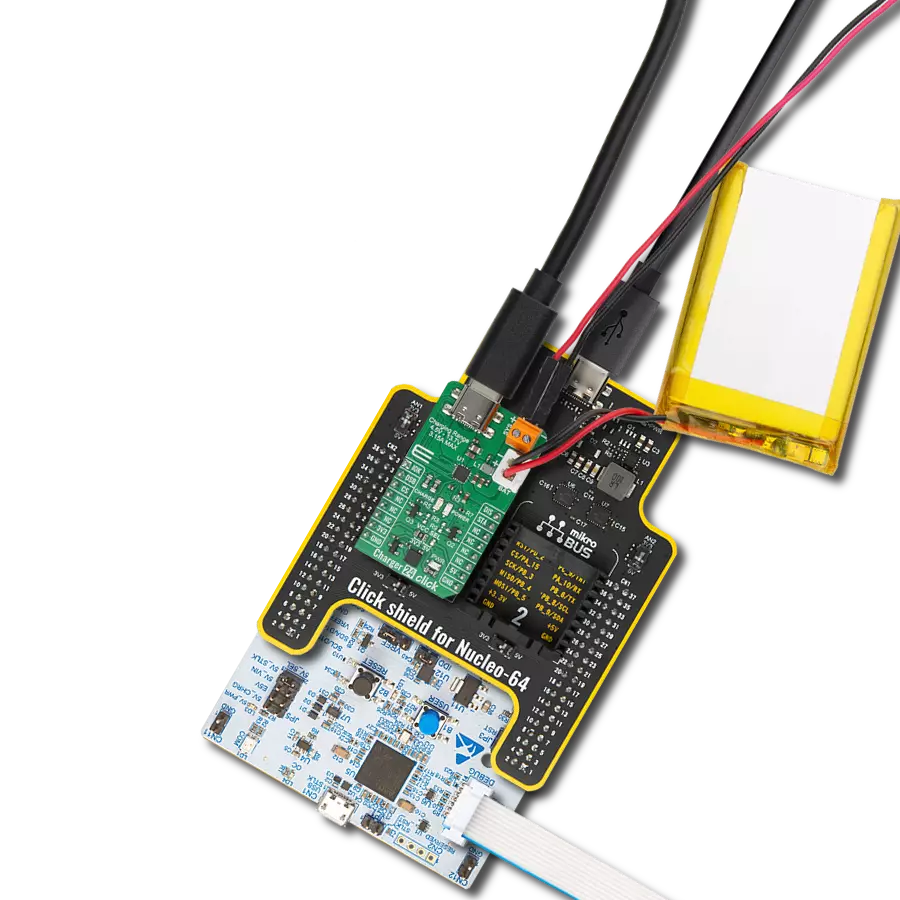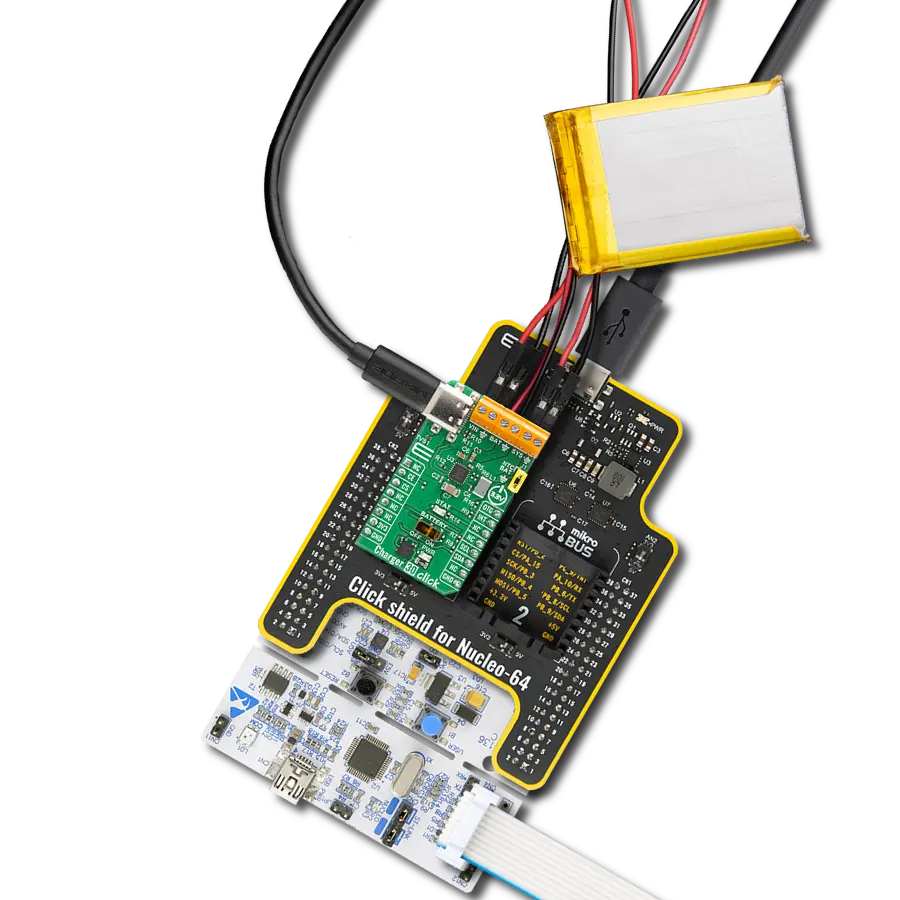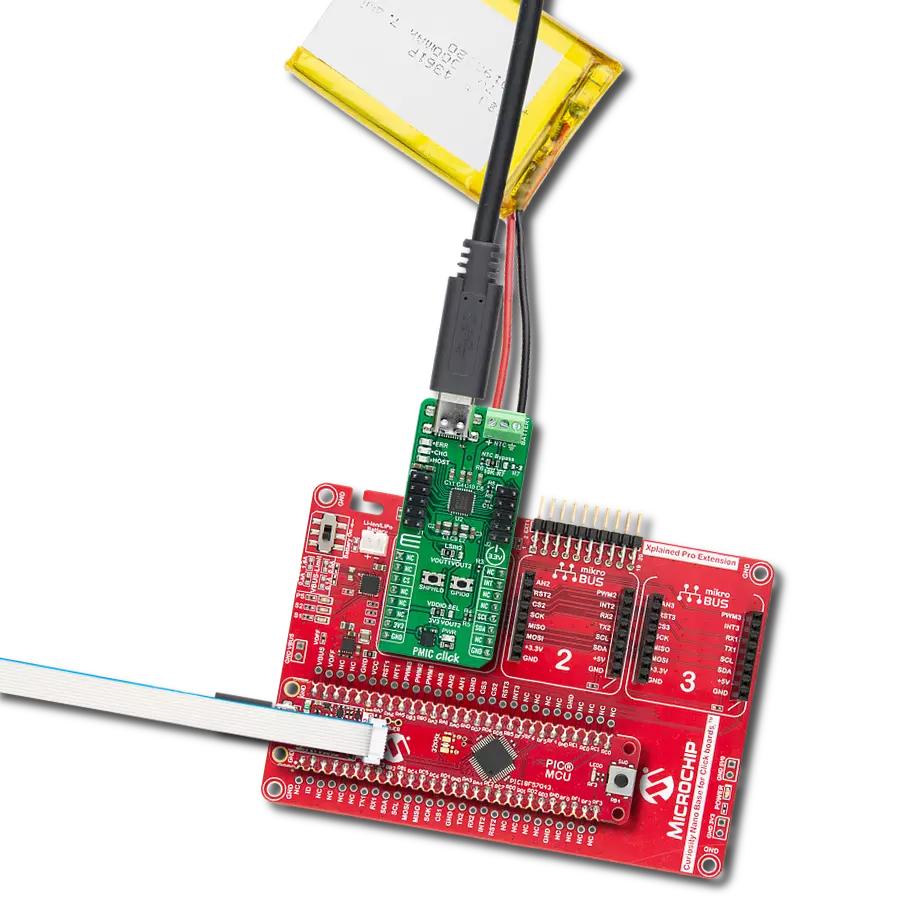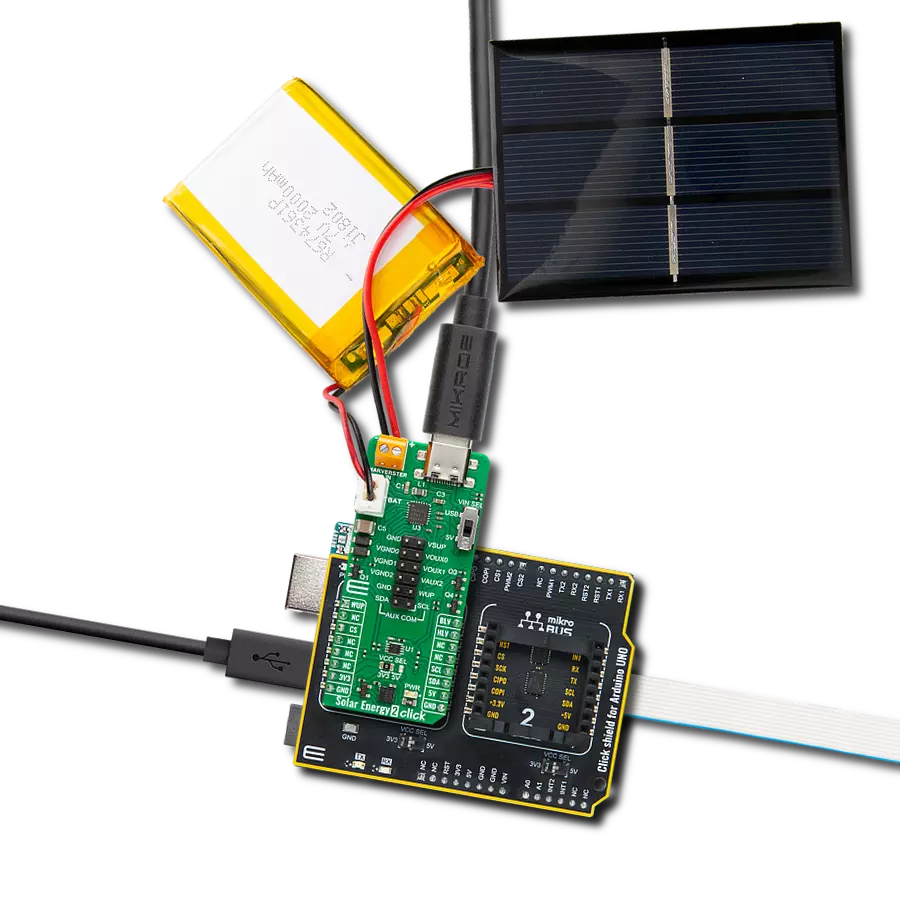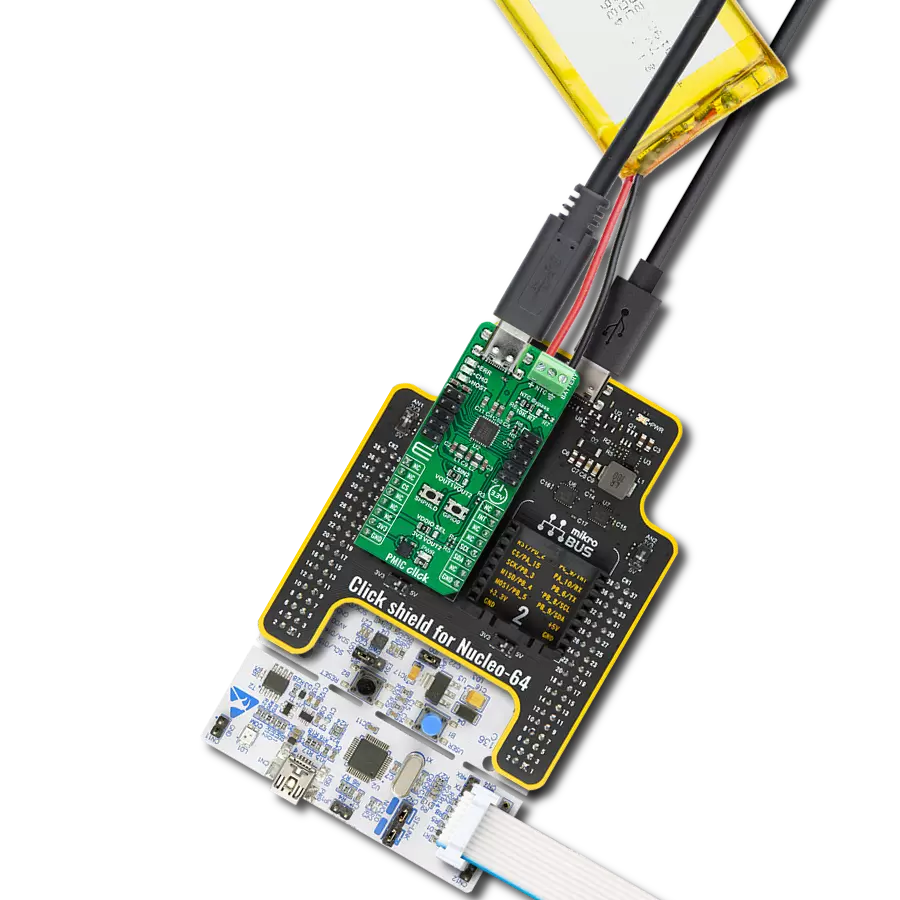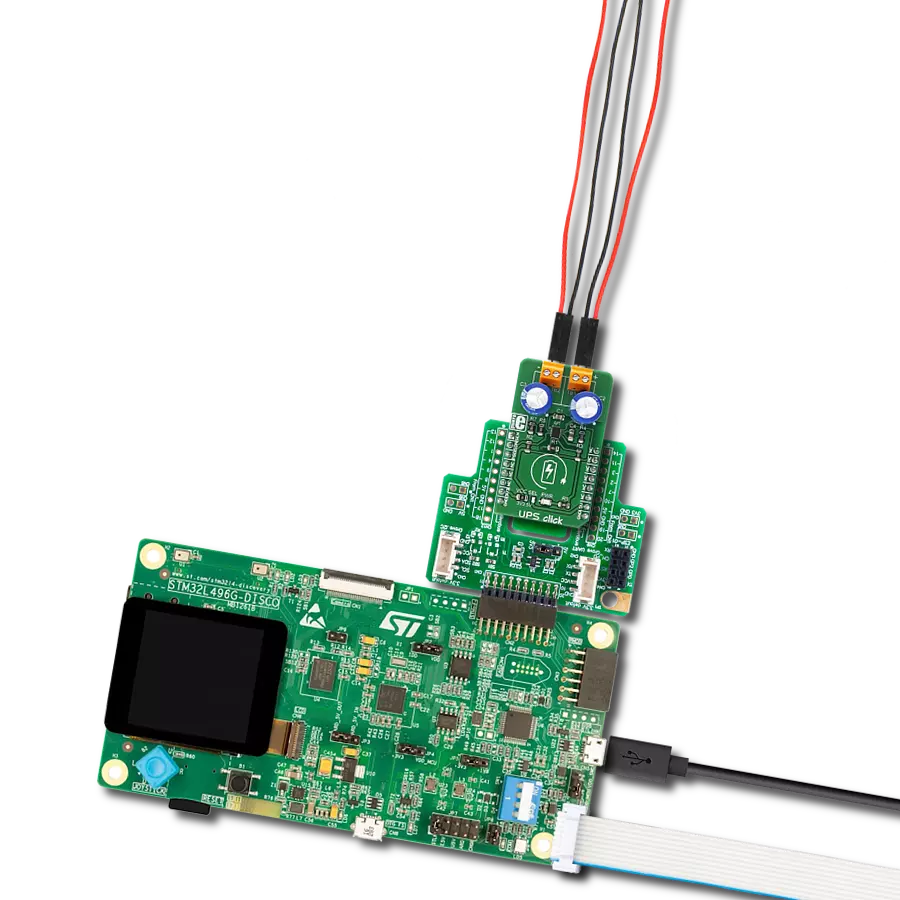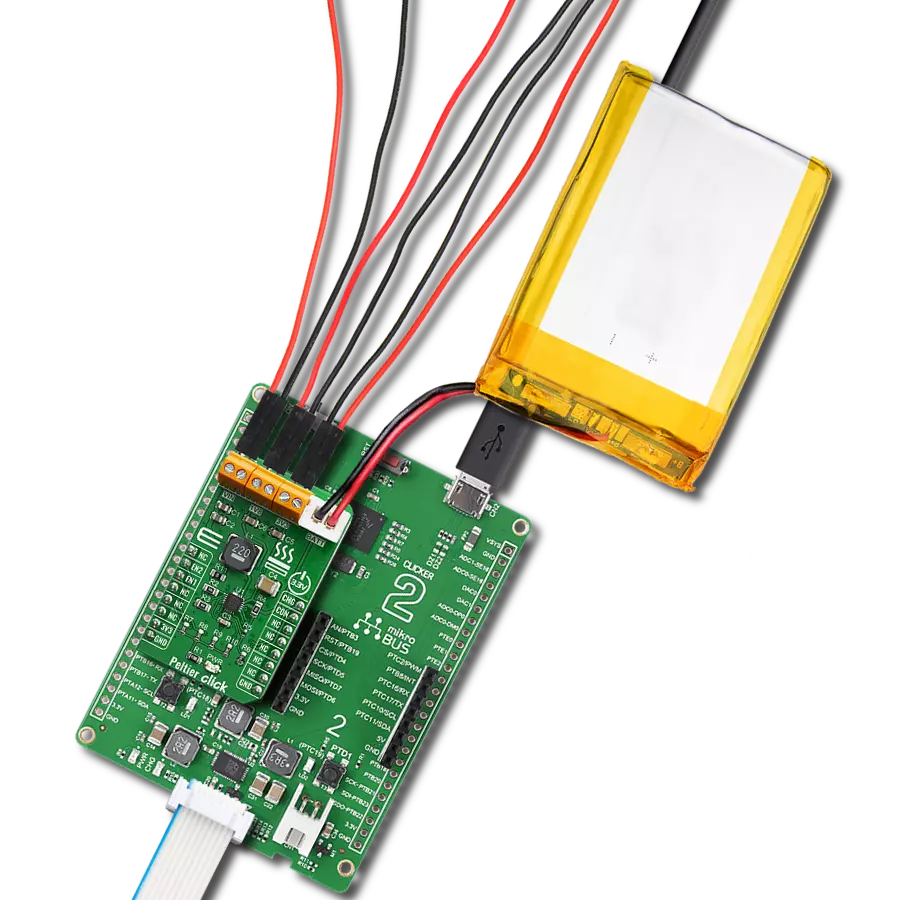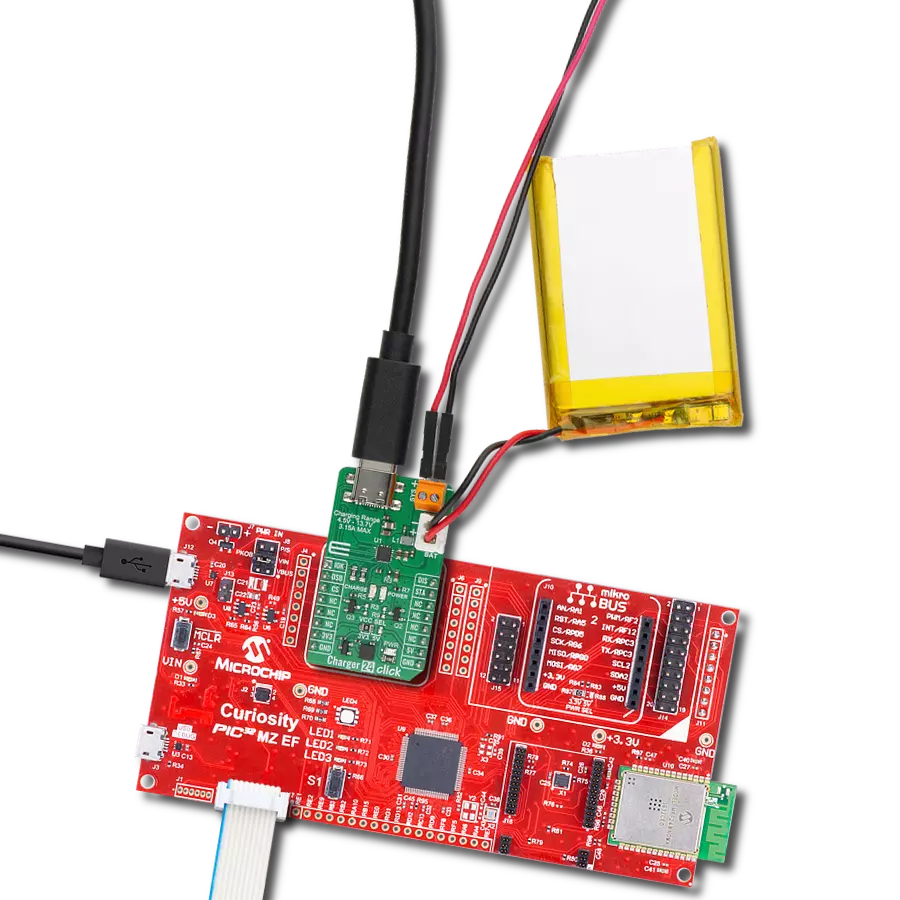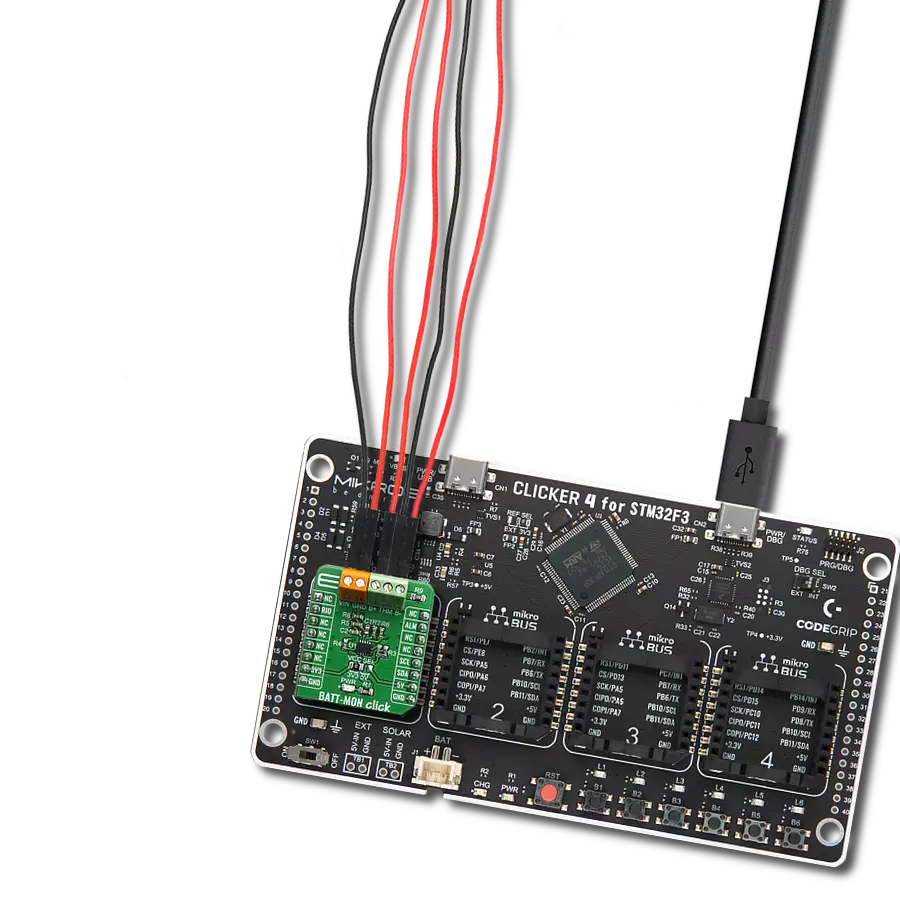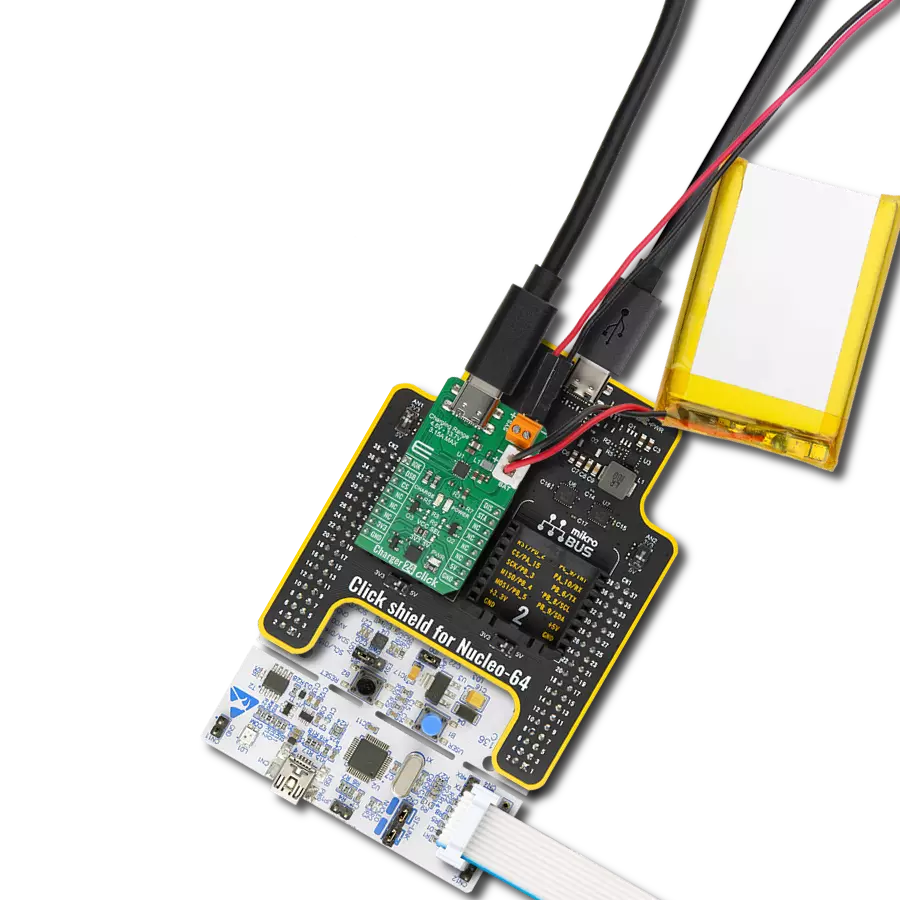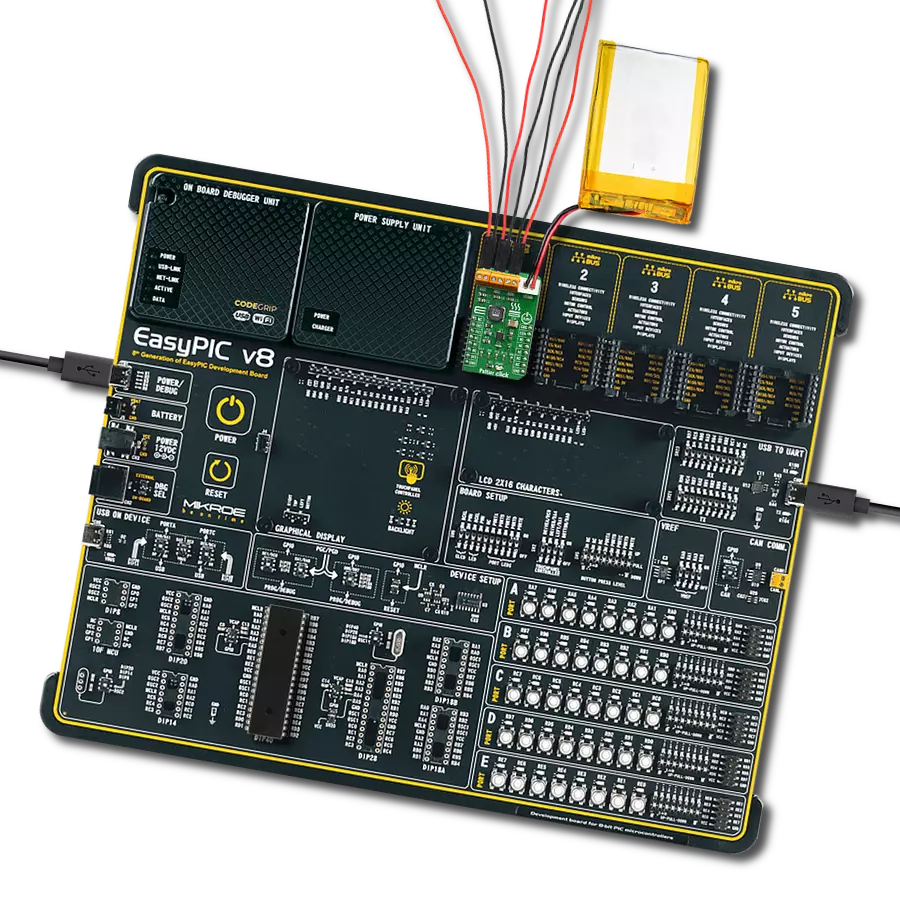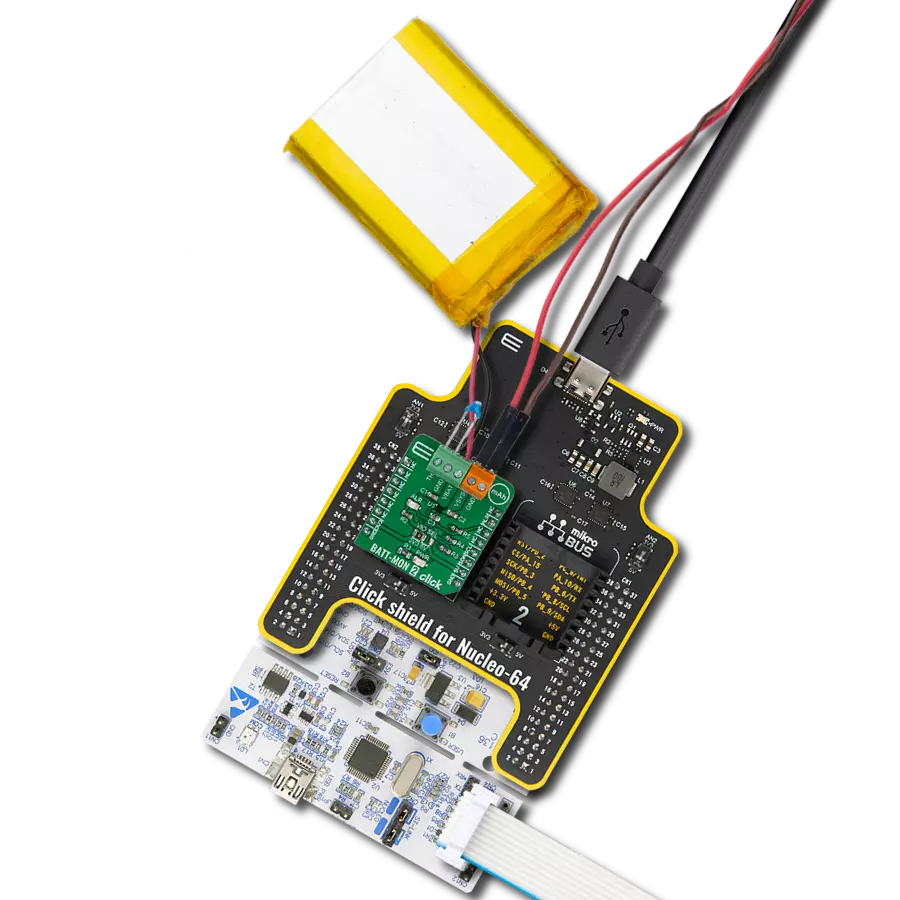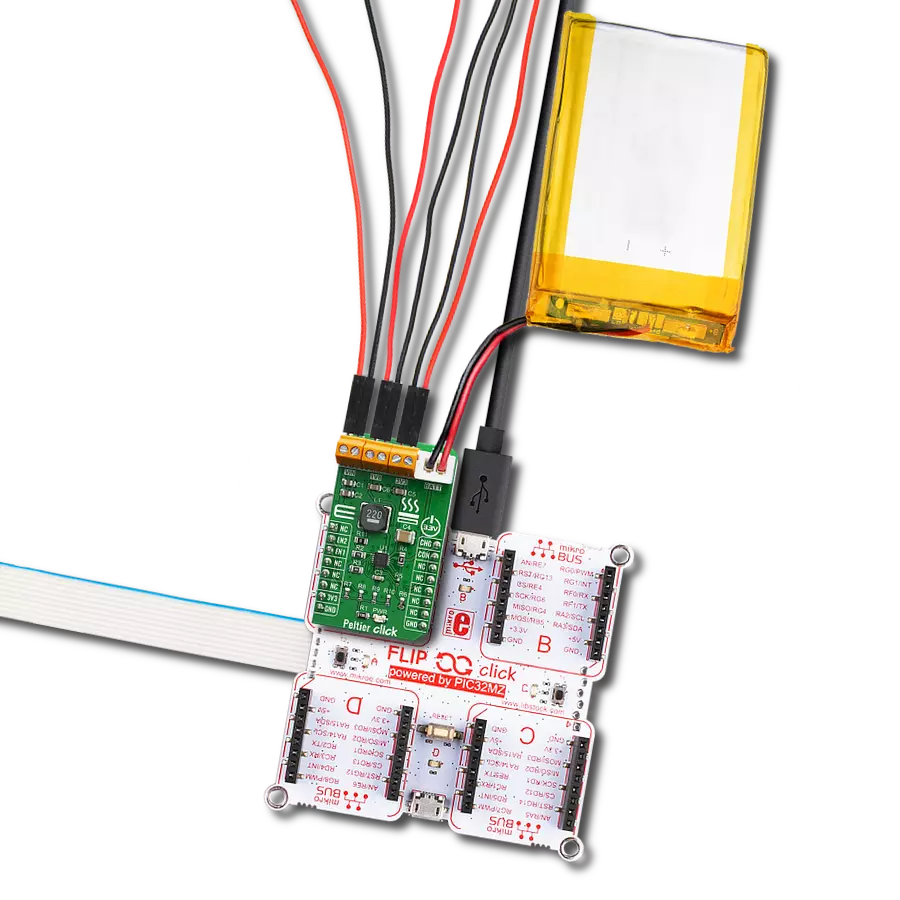Don't let a dead battery catch you off guard - choose innovative fuel gauge and battery diagnostics technology to track battery health and ensure optimal performance
A
A
Hardware Overview
How does it work?
BATT-MON 3 Click is based on the BQ35100, battery fuel gauge, and end-of-service monitor from Texas Instruments that provide gas gauging for lithium thionyl chloride (Li-SOCl2) and lithium manganese dioxide (Li-MnO2) primary batteries without requiring any forced discharge of the battery. The primary lithium gas gauging function uses voltage, current, and temperature data to provide accurate results alongside an ultra-low average power consumption. It also uses patented TI gauging algorithms to support the option of seamlessly replacing an old battery with a new one. This device measures the BT input using the integrated delta-sigma ADC, scaled by the internal translation network, through the ADC. A calibration process determines the translation gain function. It can also operate in three distinct modes: accumulator (ACC), state-of-health (SOH), and end-of-service (EOS)
mode. The device can be configured and used for only one of these modes in the field, as it is not intended to be able to switch between modes when in regular use. BATT-MON 3 Click communicates with MCU using the standard I2C 2-Wire interface to read data and configure settings with a maximum frequency of 400kHz. The BQ35100 is intended for systems with battery electronics that consume a low average current. This board is designed to be fully powered OFF when not required by controlling the enable pin routed to the PWM pin of the mikroBUS™ socket. When this pin is low, the Click board™ is fully powered down with no measurements being made, and no data is retained unless in a flash. An alarm and interrupt function is also available that outputs an interrupt signal to the ALR pin of the mikroBUS™ socket based on various configurable status and data options.
This feature is also indicated by a red LED marked as ALR. Besides, this Click board™ also features battery pack temperature sensing through an integrated temperature sensor or an external NTC thermistor connected to the onboard header labeled as NTC, using the integrated delta-sigma ADC where only one source can be used at a time. This Click board™ can operate with either 3.3V or 5V logic voltage levels selected via the VCC SEL jumper. This way, both 3.3V and 5V capable MCUs can use the communication lines properly. However, the Click board™ comes equipped with a library containing easy-to-use functions and an example code that can be used, as a reference, for further development.

Features overview
Development board
PIC32MZ Clicker is a compact starter development board that brings the flexibility of add-on Click boards™ to your favorite microcontroller, making it a perfect starter kit for implementing your ideas. It comes with an onboard 32-bit PIC32MZ microcontroller with FPU from Microchip, a USB connector, LED indicators, buttons, a mikroProg connector, and a header for interfacing with external electronics. Thanks to its compact design with clear and easy-recognizable silkscreen markings, it provides a fluid and immersive working experience, allowing access anywhere and under
any circumstances. Each part of the PIC32MZ Clicker development kit contains the components necessary for the most efficient operation of the same board. In addition to the possibility of choosing the PIC32MZ Clicker programming method, using USB HID mikroBootloader, or through an external mikroProg connector for PIC, dsPIC, or PIC32 programmer, the Clicker board also includes a clean and regulated power supply module for the development kit. The USB Micro-B connection can provide up to 500mA of current, which is more than enough to operate all onboard
and additional modules. All communication methods that mikroBUS™ itself supports are on this board, including the well-established mikroBUS™ socket, reset button, and several buttons and LED indicators. PIC32MZ Clicker is an integral part of the Mikroe ecosystem, allowing you to create a new application in minutes. Natively supported by Mikroe software tools, it covers many aspects of prototyping thanks to a considerable number of different Click boards™ (over a thousand boards), the number of which is growing every day.
Microcontroller Overview
MCU Card / MCU

Architecture
PIC32
MCU Memory (KB)
1024
Silicon Vendor
Microchip
Pin count
64
RAM (Bytes)
524288
You complete me!
Accessories
Li-Polymer Battery is the ideal solution for devices that demand a dependable and long-lasting power supply while emphasizing mobility. Its compatibility with mikromedia boards ensures easy integration without additional modifications. With a voltage output of 3.7V, the battery meets the standard requirements of many electronic devices. Additionally, boasting a capacity of 2000mAh, it can store a substantial amount of energy, providing sustained power for extended periods. This feature minimizes the need for frequent recharging or replacement. Overall, the Li-Polymer Battery is a reliable and autonomous power source, ideally suited for devices requiring a stable and enduring energy solution. You can find a more extensive choice of Li-Polymer batteries in our offer.
Used MCU Pins
mikroBUS™ mapper
Take a closer look
Click board™ Schematic

Step by step
Project assembly
Track your results in real time
Application Output
1. Application Output - In Debug mode, the 'Application Output' window enables real-time data monitoring, offering direct insight into execution results. Ensure proper data display by configuring the environment correctly using the provided tutorial.

2. UART Terminal - Use the UART Terminal to monitor data transmission via a USB to UART converter, allowing direct communication between the Click board™ and your development system. Configure the baud rate and other serial settings according to your project's requirements to ensure proper functionality. For step-by-step setup instructions, refer to the provided tutorial.

3. Plot Output - The Plot feature offers a powerful way to visualize real-time sensor data, enabling trend analysis, debugging, and comparison of multiple data points. To set it up correctly, follow the provided tutorial, which includes a step-by-step example of using the Plot feature to display Click board™ readings. To use the Plot feature in your code, use the function: plot(*insert_graph_name*, variable_name);. This is a general format, and it is up to the user to replace 'insert_graph_name' with the actual graph name and 'variable_name' with the parameter to be displayed.

Software Support
Library Description
This library contains API for BATT-MON 3 Click driver.
Key functions:
battmon3_read_voltageThis function reads the battery voltage in millivolts.battmon3_read_currentThis function reads the battery current load from BATT+ to GND in milliamps.battmon3_read_used_capacityThis function reads the used battery capacity in mAh.
Open Source
Code example
The complete application code and a ready-to-use project are available through the NECTO Studio Package Manager for direct installation in the NECTO Studio. The application code can also be found on the MIKROE GitHub account.
/*!
* @file main.c
* @brief BATTMON3 Click example
*
* # Description
* This example demonstrates the use of BATT-MON 3 Click by measuring the battery
* voltage, current and used capacity, as well as the chip internal temperature.
*
* The demo application is composed of two sections :
*
* ## Application Init
* Initialized the driver and performs the Click default configuration.
*
* ## Application Task
* Reads the battery voltage (mV), current (mA), used capacity (mAh) and the chip internal
* temperature (Celsius) and displays the results on the USB UART approximately once per second.
*
* @author Stefan Filipovic
*
*/
#include "board.h"
#include "log.h"
#include "battmon3.h"
static battmon3_t battmon3;
static log_t logger;
void application_init ( void )
{
log_cfg_t log_cfg; /**< Logger config object. */
battmon3_cfg_t battmon3_cfg; /**< Click config object. */
/**
* Logger initialization.
* Default baud rate: 115200
* Default log level: LOG_LEVEL_DEBUG
* @note If USB_UART_RX and USB_UART_TX
* are defined as HAL_PIN_NC, you will
* need to define them manually for log to work.
* See @b LOG_MAP_USB_UART macro definition for detailed explanation.
*/
LOG_MAP_USB_UART( log_cfg );
log_init( &logger, &log_cfg );
log_info( &logger, " Application Init " );
// Click initialization.
battmon3_cfg_setup( &battmon3_cfg );
BATTMON3_MAP_MIKROBUS( battmon3_cfg, MIKROBUS_1 );
if ( I2C_MASTER_ERROR == battmon3_init( &battmon3, &battmon3_cfg ) )
{
log_error( &logger, " Communication init." );
for ( ; ; );
}
if ( BATTMON3_ERROR == battmon3_default_cfg ( &battmon3 ) )
{
log_error( &logger, " Default configuration." );
for ( ; ; );
}
log_info( &logger, " Application Task " );
}
void application_task ( void )
{
uint16_t voltage;
int16_t current;
float temperature, used_capacity;
if ( BATTMON3_OK == battmon3_read_voltage ( &battmon3, &voltage ) )
{
log_printf ( &logger, " Voltage: %u mV\r\n", voltage );
}
if ( BATTMON3_OK == battmon3_read_current ( &battmon3, ¤t ) )
{
log_printf ( &logger, " Current: %d mA\r\n", current );
}
if ( BATTMON3_OK == battmon3_read_temperature ( &battmon3, &temperature ) )
{
log_printf ( &logger, " Temperature: %.3f C\r\n", temperature );
}
if ( BATTMON3_OK == battmon3_read_used_capacity ( &battmon3, &used_capacity ) )
{
log_printf ( &logger, " Used Capacity: %.3f mAh\r\n\n", used_capacity );
}
Delay_ms ( 1000 );
}
int main ( void )
{
/* Do not remove this line or clock might not be set correctly. */
#ifdef PREINIT_SUPPORTED
preinit();
#endif
application_init( );
for ( ; ; )
{
application_task( );
}
return 0;
}
// ------------------------------------------------------------------------ END
Additional Support
Resources
Category:Battery charger


















